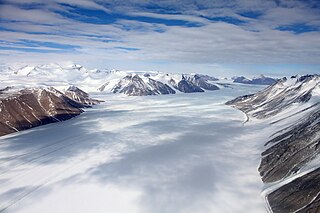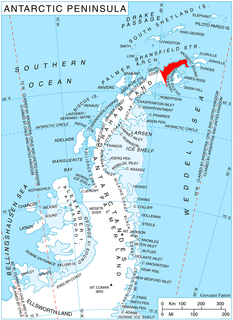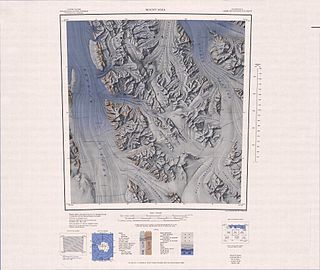Related Research Articles

Commonwealth Glacier is a glacier which flows in a southeasterly direction and enters the northern side of Taylor Valley immediately west of Mount Coleman, in Victoria Land, Antarctica. It was charted by the British Antarctic Expedition, 1910–13, under Robert Falcon Scott, and named by them for the Commonwealth of Australia, which made a financial grant to the BrAE and contributed two members to the Western Geological Party which explored this area. The north end of the glacier is bounded by Flint Ridge.

Ferrar Glacier is a glacier in Antarctica. It is about 35 nautical miles long, flowing from the plateau of Victoria Land west of the Royal Society Range to New Harbour in McMurdo Sound. The glacier makes a right (east) turn northeast of Knobhead, where it also feeds the upper end of the Taylor Glacier, which flows on the other (northern) side of the Kukri Hills from the Ferrar Glacier, which continues east along the south side of the Kukri Hills to New Harbour.

Lake Bonney is a saline lake with permanent ice cover at the western end of Taylor Valley in the McMurdo Dry Valleys of Victoria Land, Antarctica.
Penck Glacier is a small glacier flowing northward along the west side of Bertrab Nunatak to Vahsel Bay. Discovered by the German Antarctic Expedition, 1911–12, under Wilhelm Filchner, who named this feature for German geographer Albrecht Penck.

Cain Nunatak is the westernmost of two isolated nunataks on the south side of Broad Valley, situated 3.37 km east-northeast of Kumata Hill on Trinity Peninsula, Antarctica. It is a volcanic feature and an inferred vent of the James Ross Island Volcanic Group.
Ball Peak is a peak rising to 1,700 metres (5,600 ft) at the head of Loftus Glacier in the Asgard Range, Victoria Land. It stands 0.7 nautical miles (1.3 km) south-west of Mount McLennan in proximity to Mount Hall and Harris Peak, with which this naming is associated. It was named by New Zealand Geographic Board (1998) after Gary Ball, a New Zealand Antarctic Division field guide and instructor in survival training at Scott Base, 1976–77; field guide, northern Victoria Land GANOVEX expedition, 1979–80. Gary Ball died in the Himalayas, 1993.
Bol Glacier is a glacier between Darkowski Glacier and Condit Glacier, flowing north from the Cathedral Rocks into Ferrar Glacier in Victoria Land. It was named by the Advisory Committee on Antarctic Names in 1964, for Lieutenant Commander Peter Bol, U.S. Navy, chaplain with the winter party of 1956 at the Naval Air Facility on McMurdo Sound.
Conrow Glacier is a small glacier, next westward of Bartley Glacier, that drains north from the Asgard Range partway down the south wall of Wright Valley, Victoria Land, Antarctica. It was named by Roy E. Cameron, leader of a United States Antarctic Research Program biological party to the area in 1966–67, for Howard P. Conrow, a member of that party.
Dauphin Pond is a freshwater frozen pond in the Labyrinth of Wright Valley, McMurdo Dry Valleys. The pond is near the southwest extremity of Healy Trough, 0.2 nautical miles (0.4 km) east of the Wright Upper Glacier terminus. It was named by the Advisory Committee on Antarctic Names (2004) after a United States Coast Guard Dauphin helicopter (HH-65A) that landed on the pond January 20, 2004, in the course of sampling the pond.
Kukri Hills is a prominent east-west trending range, about 25 nautical miles (46 km) long and over 2,000 metres (6,600 ft) high, forming the divide between Ferrar Glacier on the south and Taylor Glacier and Taylor Valley on the north, in Victoria Land, Antarctica.
Doran Stream is a meltwater stream, 3 kilometres (2 mi) long, flowing north from Doran Glacier east of Sollas Glacier to Priscu Stream in Taylor Valley, Victoria Land. It was named by the Advisory Committee on Antarctic Names in 1996 after Peter Doran, a paleolimnologist currently an endowed chair at Louisiana State University, who has conducted studies of the paleolimnology and climate of the McMurdo Dry Valleys since 1993.
Fogle Peak is a distinctive pointed peak, 2,475 metres (8,120 ft) high, standing at the head of Kamb Glacier in the Royal Society Range of Victoria Land, Antarctica. It was named in 1992 by the Advisory Committee on Antarctic Names after Benson Fogle, Program Manager for Upper Atmospheric Research, Division of Polar Programs, National Science Foundation, 1976–85.
Goldman Glacier is a glacier 2 nautical miles (4 km) east of Marr Glacier, flowing north from the Kukri Hills into Taylor Valley in Victoria Land, Antarctica. It was named by the Advisory Committee on Antarctic Names for United States Antarctic Research Program biologist Charles R. Goldman, who made studies in the area in the 1962–63 season.
Lizotte Creek is a meltwater stream, 2,000 metres (2,200 yd) long, flowing southeastwards from the extreme southwestern tip of Matterhorn Glacier to the northeast end of Lake Bonney in Taylor Valley, Victoria Land, Antarctica. It was named by the Advisory Committee on Antarctic Names in 1996 after Michael P. Lizotte, a biologist at the University of Wisconsin–Oshkosh, who studied algal physiology and ecology in perennially ice-covered lakes in the McMurdo Dry Valleys area from 1985 to 2008.

Mount Soza is a massive mountain (2,190 m) in the Bowers Mountains that comprises the east wall of the Rennick Glacier between the entry points of the tributary Alt and Carryer Glaciers. Named by Advisory Committee on Antarctic Names (US-ACAN) after Ezekiel R. Soza, United States Geological Survey (USGS) topographic engineer, a member of USGS Topo North and South, 1961–62, and Topo East and West, 1962–63. Using Army turbine helicopters for rapid movement, these survey parties established geodetic control in the Transantarctic Mountains between the Cape Hallett area and Beardmore Glacier during the first season ; during the second season geodetic control was extended from Cape Hallett to Wilson Hills, and from the foot of Beardmore Glacier through the Horlick Mountains. Soza was leader of the USGS mapping party in the Pensacola Mountains, 1965–66 season.
Tarn Valley is an elevated ice-free valley, 1.5 nautical miles (2.8 km) long, containing four tarns named after American universities, Yale Tarn, Harvard Tarn, Princeton Tarn, and Penn Tarn, located at the north side of lower Taylor Valley, north of Mount Falconer, in Victoria Land. This valley was visited in the 1965-66 field season by Victoria University of Wellington Antarctic Expedition (VUWAE) which named the tarns. The valley was named in association with the tarns by the Advisory Committee on Antarctic Names in 1997.
The Hothem Cliffs are a line of abrupt rock cliffs at the north side of the head of Canada Glacier in the Asgard Range of Victoria Land, Antarctica. They were named by the Advisory Committee on Antarctic Names in 1997 after Larry D. Hothem, an American geodesist who wintered-over with the Australian National Antarctic Research Expeditions at Mawson Station in 1969, and with the United States Geological Survey from 1991. Just west of the cliffs is Unwin Ledge.
Cape Reynolds is a rocky cape marking the south side of the terminus of David Glacier, on the coast of Victoria Land. Discovered by the British Antarctic Expedition, 1907–09, under Shackleton, who probably named this feature for Jeremiah (John) N. Reynolds, an American who long agitated for exploration of the Antarctic, and who was one of the principal promoters of the U.S. Exploring Expedition, 1838–42.
Mount Hall is a peak rising to 1,800 metres (5,900 ft) 1.6 nautical miles (3 km) southwest of Mount Weyant in the Asgard Range, Victoria Land. Mount Hall stands close westward of Harris Peak and Ball Peak, with which this naming is associated. It was named by the New Zealand Geographic Board in 1998, after Rob Hall, a guide who worked two seasons for the New Zealand Antarctic Research Programme as a field training instructor and, in the 1990s, guided clients on climbs in the Ellsworth Mountains.
Harris Peak is a peak rising to 1,750 metres (5,740 ft) 1.4 nautical miles (2.6 km) south of Mount Weyant in the Asgard Range of Victoria Land, Antarctica. It is located between Mount Hall and Ball Peak, with which this naming is associated. It was named by the New Zealand Geographic Board in 1998 after A.M. "Andy" Harris, a guide and New Zealand Antarctic Research Program field leader, 1987–92, including two trips to Marie Byrd Land.
References
 This article incorporates public domain material from the United States Geological Survey document: "Bohner Stream".(content from the Geographic Names Information System )
This article incorporates public domain material from the United States Geological Survey document: "Bohner Stream".(content from the Geographic Names Information System )